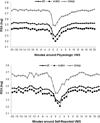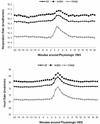Changes in heart rate variability during vasomotor symptoms among midlife women
- PMID: 26926327
- PMCID: PMC4844776
- DOI: 10.1097/GME.0000000000000586
Changes in heart rate variability during vasomotor symptoms among midlife women
Abstract
Objective: Most midlife women report vasomotor symptoms (VMS), yet their physiology remains poorly understood. This study tested whether acute decreases in cardiac vagal control would occur with VMS in a large sample of women monitored during wake and sleep.
Methods: Two hundred and fifteen nonsmoking women aged 40 to 60 years with evidence of VMS were included. Women were free of a history of clinical cardiovascular disease or arrhythmia; or use of insulin, beta blockers, calcium channel blockers, or medications impacting VMS. Women underwent 24 hours of ambulatory monitoring for physiological (sternal skin conductance) and self-report (electronic diary) measurement of VMS; heart rate variability (electrocardiogram); and respiratory rate. Changes in cardiac vagal control as assessed by respiratory sinus arrhythmia during VMS, relative to periods before and after VMS, were tested in linear mixed models.
Results: Significant decreases in respiratory sinus arrhythmia were observed during physiologically measured VMS relative to periods preceding (b[SE] = 0.13 (0.004), P < 0.0001) and after the vasomotor symptoms (b[SE] = 0.13 (0.004), P < 0.0001), adjusted for age, race, body mass index, and sleep/wake status. Decreases were observed for women not aware of their VMS, and differences persisted controlling for respiration rate. Interactions indicated that respiratory sinus arrhythmia decreases were most pronounced during sleep and for younger women.
Conclusions: Physiologically measured VMS were accompanied by an inhibition of cardiac vagal control in a large sample of women. Changes were observed irrespective of whether the VMS were reported, were most pronounced during sleep, and were greatest among younger women. These findings contribute to the understanding of vasomotor symptom physiology.
Conflict of interest statement
N Santoro received a research grant from Bayer Healthcare and owns stock options in Menogenix. No other authors have conflicts of interests or disclosures.
Figures
Similar articles
-
Are vasomotor symptoms associated with sleep characteristics among symptomatic midlife women? Comparisons of self-report and objective measures.Menopause. 2012 Jul;19(7):742-8. doi: 10.1097/gme.0b013e3182422973. Menopause. 2012. PMID: 22415568 Free PMC article.
-
Childhood abuse and vasomotor symptoms among midlife women.Menopause. 2019 Oct;26(10):1093-1099. doi: 10.1097/GME.0000000000001366. Menopause. 2019. PMID: 31166306 Free PMC article.
-
Is heart rate variability associated with frequency and intensity of vasomotor symptoms among healthy perimenopausal and postmenopausal women?Clin Auton Res. 2016 Feb;26(1):7-13. doi: 10.1007/s10286-015-0322-x. Epub 2015 Dec 21. Clin Auton Res. 2016. PMID: 26691637 Free PMC article. Clinical Trial.
-
Understanding the pathophysiology of vasomotor symptoms (hot flushes and night sweats) that occur in perimenopause, menopause, and postmenopause life stages.Arch Womens Ment Health. 2007;10(6):247-57. doi: 10.1007/s00737-007-0209-5. Epub 2007 Dec 12. Arch Womens Ment Health. 2007. PMID: 18074100 Review.
-
Sleep and menopause: a narrative review.Menopause. 2015 Aug;22(8):899-915. doi: 10.1097/GME.0000000000000499. Menopause. 2015. PMID: 26154276 Review.
Cited by
-
Changes in heart rate and blood pressure during nocturnal hot flashes associated with and without awakenings.Sleep. 2019 Oct 21;42(11):zsz175. doi: 10.1093/sleep/zsz175. Sleep. 2019. PMID: 31408175 Free PMC article.
-
Hormone Replacement Therapy: Would it be Possible to Replicate a Functional Ovary?Int J Mol Sci. 2018 Oct 14;19(10):3160. doi: 10.3390/ijms19103160. Int J Mol Sci. 2018. PMID: 30322209 Free PMC article. Review.
-
Hot flashes and awakenings among midlife women.Sleep. 2019 Sep 6;42(9):zsz131. doi: 10.1093/sleep/zsz131. Sleep. 2019. PMID: 31152182 Free PMC article.
-
An Evaluation of DNA Methylation Levels and Sleep in Relation to Hot Flashes: A Cross-Sectional Study.J Clin Med. 2024 Jun 15;13(12):3502. doi: 10.3390/jcm13123502. J Clin Med. 2024. PMID: 38930031 Free PMC article.
-
Vasomotor symptoms: natural history, physiology, and links with cardiovascular health.Climacteric. 2018 Apr;21(2):96-100. doi: 10.1080/13697137.2018.1430131. Epub 2018 Feb 2. Climacteric. 2018. PMID: 29390899 Free PMC article. Review.
References
Publication types
MeSH terms
Grants and funding
LinkOut - more resources
Full Text Sources
Other Literature Sources



